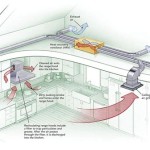From low-flow to high-flow, knowing the kitchen faucet flow rate is important for many reasons. Having the right flow rate can help you save on your water bill, conserve energy, and ensure that you have enough water pressure for all of your tasks in the kitchen. But finding the right flow rate can be a bit confusing, so let’s take a closer look at kitchen faucet flow rate and how it works.
What is a Kitchen Faucet Flow Rate?
A kitchen faucet flow rate is the rate at which water flows from your faucet. It is measured in gallons per minute (GPM) and is usually indicated on the packaging or in the manufacturer’s specifications. The higher the number, the higher the flow rate.
How to Calculate Kitchen Faucet Flow Rate
Calculating your kitchen faucet flow rate is easy. All you need to do is measure the water coming out of your faucet in a one-minute time period. To do this, fill a one-gallon container and time how long it takes to fill it. If it takes one minute, then your faucet’s flow rate is one gallon per minute (GPM). If it takes two minutes, then your flow rate is half a gallon per minute (0.5 GPM).
Types of Kitchen Faucet Flow Rates
There are three main types of kitchen faucet flow rates: low-flow, medium-flow, and high-flow. Low-flow faucets typically have a flow rate of 1.5 GPM or lower and are designed to conserve water. Medium-flow faucets typically have a flow rate of 1.5 to 2.2 GPM and are designed to provide enough water for everyday tasks. High-flow faucets typically have a flow rate of 2.2 GPM or higher and are designed for tasks that require a lot of water, such as washing large pots and pans.
Benefits of a Low-Flow Kitchen Faucet
Low-flow kitchen faucets are becoming increasingly popular due to their many benefits. They help conserve water, reduce energy costs, and can even help protect the environment. Low-flow faucets also have a much lower water pressure, which means they are less likely to splash and are easier to control. This makes them ideal for tasks such as washing delicate items.
Choosing the Right Flow Rate
Choosing the right flow rate for your kitchen faucet depends on your needs and preferences. If you want to conserve water and energy, then a low-flow faucet is a good choice. If you need a lot of water for tasks like washing large pots and pans, then a high-flow faucet is a better option. Ultimately, it’s up to you to decide which flow rate is best for your kitchen.















Related Posts








